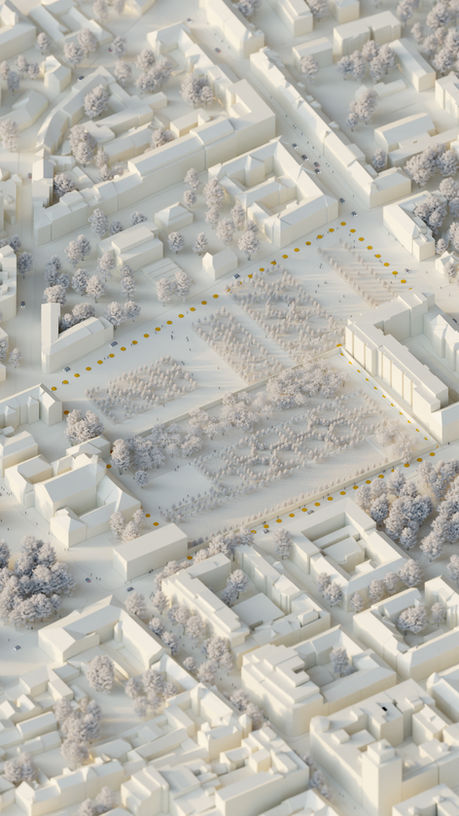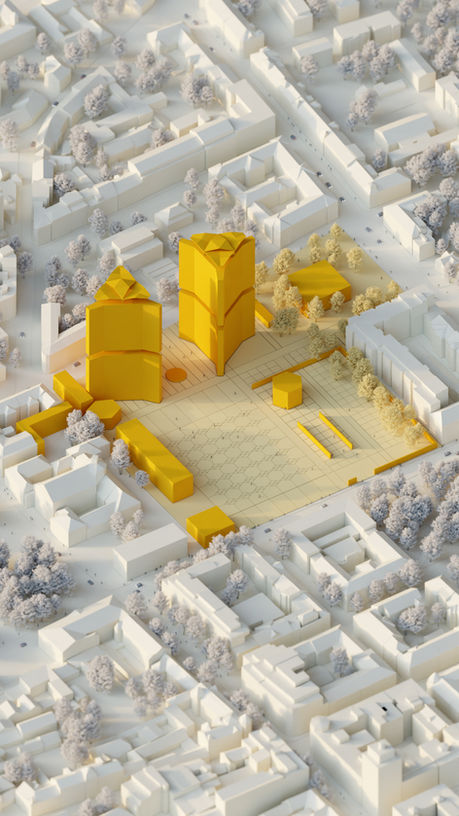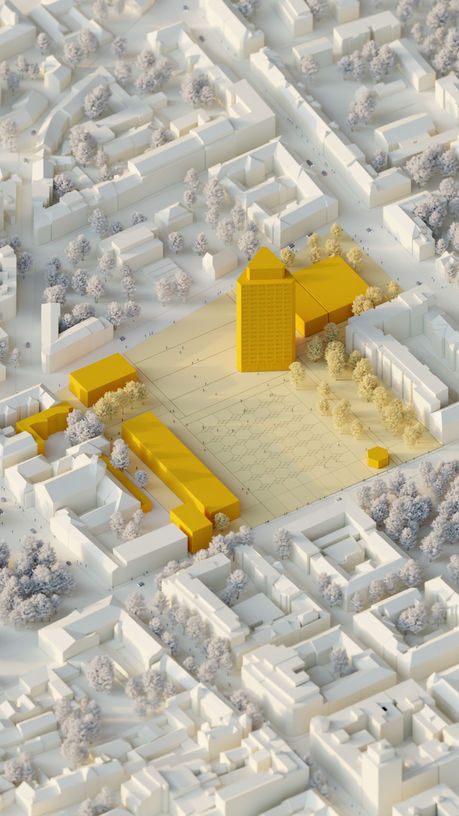
Ideas for a new exhibition building at the time "of the elimination of the Jakopič Pavilion"
Ljubljana's Jakopič Pavilion was the first purpose-built art exhibition centre in Slovenia, which served as the central space for the presentation of contemporary art until the opening of the Modern Gallery in 1948. The Art Nouveau building, located at the beginning of Latterman's Alley in Tivoli Park and designed with a similar idea as the Secession or Zedlitzhalle buildings in Vienna, was erected in 1908 by the leading Slovenian impressionist painter Rihard Jakopič "at his own expense and with his own resources", as the city authorities did not comply with his request to build an art exhibition centre. However, they did eventually cede a meadow next to the railway line for the purpose of construction.
The sketches and several plans for the pavilion, which Jakopič presented to the authorities as a "provisional" building, were drawn up free of charge by the architect Maks Fabiani. The one-storey building with a prominent colonnaded entrance contained six exhibition spaces of varying heights, covered by an undulating roof and three domes, supported by a timber structure complemented by brick infills.
The pavilion hosted its first exhibition in 1909, but a decade and a half after its construction, Jakopič sold it to the Municipality of Ljubljana due to financial problems, and from at least 1958 there were discussions about its removal. In early 1962, it was demolished due to the shifting of the railway line. The building has remained in the memory of many inhabitants of Ljubljana, artists, connoisseurs and lovers of art and architecture, but the efforts and conceptual designs for a new Jakopič Pavilion, which were considered as early as the beginning of the 1960s, remain mostly unknown today.

The first ideas for the new Jakopič Pavilion were related to the artists' distress at the announced demolition of the exhibition centre in Tivoli, which was so important to them, as we can read in the archival material. A letter from the Secretariat of the Council for Education and Culture of the People's Republic of Slovenia, dated October 1961, records the importance the artists attached to the building, not primarily as an architectural creation, but as a framework of the programme it made possible. "About two years ago, when plans for the Ljubljana railway junction were becoming more concrete, urban planners announced, among other things, the demolition of the Jakopič Pavilion. They calculated that the value of the materials in the long-worn, damp and rickety building, which is being saved only visually with paintwork and the like, is around 1 million dinars. This is, of course, only an account of the materials that will be destroyed, whereas the function that the pavilion has performed, which will cease with its demolition, cannot be expressed in figures." The campaign for a new exhibition building, the so-called Jakopič Pavilion of Fine Arts, was initiated by the Slovenian Fine Artists Association (DSLU), which, at the time, did not have its own space. The Association argued that the exhibition of artworks was particularly "critical because the Modern Gallery must cease to exhibit continuously, and organise once and for all its permanent collection of our nation's greatest contemporary works of art. It must become a true gallery and not an exhibition centre." It was pointed out that exhibitions were possible only in the Mala galerija, which was the exhibition salon and later the complementary exhibition space of the Modern Gallery in the building of the Ljubljanska kreditna banka (today the building of the Bank of Slovenia) on Slovenska Street, where "domestic and foreign luminaries" were given the opportunity to exhibit their works. As an additional reason, they also cited the fact that the Jakopič Pavilion was intended primarily for young people, whom the public was only just getting to know, and stressed that without the opportunity to exhibit, "(...) no artist can have an artistic identity. A diploma from the Academy alone does not provide that." The DSLU, chaired at the time by the painter, graphic artist and one of the leading professors at the Ljubljana Academy of Fine Arts, France Mihelič, formed a preparatory committee in March 1961 for the erection of a new exhibition centre, which was to provide construction ideas and start looking for a location. This task was taken over by a working group of the committee, which consisted of four painters, Viktor Snoj, Zoran Didek, Ivan Seljak and Janez Pirnat, and included other prominent Slovenian artists of the past century - in addition to Mihelič, there were Božidar Jakac and Boris Kalin, as well as two art historians and art critics: the director of the Modern Gallery Zoran Kržišnik and Špelca Čopič.

Several sites in the city centre were assessed, namely the area between Župančičeva Street and the Figovec Inn at the intersection of Slovenska and Gosposvetska Streets, including "the extension of the western front of Slavija towards Figovec", as well as the area of the new Revolution Square, today's Republic Square, and the vicinity of the Orthodox Church. The Committee for the erection of the new exhibition centre also discussed possible locations with the heads of the district and state Institute for Urban Planning, with a view to the construction of the cultural centre of Ljubljana. It was decided that the building should be built in the context of existing art institutions such as the Modern Gallery, the National Gallery and the Mala galerija, in what was known as the "focal point of the city's cultural centre". Finally, two possible sites were chosen. The first was on Revolution Square, "where the building should be four storeys high, according to the district town planners". The second possible site was identified as the area behind the Orthodox Church, along Prešernova Street, opposite the now demolished Delegates Club. Here, the construction was to be "built as a two-storey building", which suited the Association better, both in terms of location and the design of the building itself.
In August 1961, the Committee prepared a study, the so-called "Orientation Programme for the Construction of Jakopič Pavilion of Fine Arts", and the framework programme was drawn up by the painter Zoran Didek and the civil engineer Josip Didek, better known as the designer of many industrial buildings, under the auspices of the architectural bureau Slovenija projekt. As the site had not yet been finally selected, only a "linear preparatory sketch" of the new building was made, which was to serve as a guide for further work and for a rough calculation of the investment costs. Although the Fabiani Pavilion was only 260 square metres, the DSLU, on the basis of the Association’s needs assessment, proposed a new building with a surface area of 1872 square metres. The building was conceived as a two-storey structure with a skeleton design in a basic 6 x 6 metre grid, brick perimeter walls enclosing the main building volume and an attached side wing. The main entrance, central entrance hall and clubhouse were to be on the ground floor, with exhibition space on the first floor and offices in the side wing. The sawtooth roof was to provide diffused northern light for the exhibition spaces and the façade was to be 'clad with more noble materials'.

Sketch of the "linear orientation plan of the new House of Fine Arts 'Jakopič Pavilion,'" created in 1961 for the DSLU by painter Zoran Didek and civil engineer Josip Didek. The original is kept in the Archives of the Republic of Slovenia, SI AS, 1529 Kraigher Boris (1945–1967), DSLU, Association of Slovene Fine Artists, elaboration of the Orientation Program for the construction of the House of Fine Arts 'Jakopič Pavilion.'
But in September 1961, the city authorities decided to locate the new exhibition centre on Revolution Square, west of the school building on Šubičeva Street, built according to the plans of architect Jože Plečnik. Namely, at the time of the "elimination of the Jakopič Pavilion", as the situation at the beginning of the 1960s is called in the above-mentioned study, the first plans were being drawn up for a new administrative and political centre of the Republic of Slovenia, to be built on the land opposite the People's Assembly building (today's Parliament building), which had been erected not long before. The conceptual solution for this representative building complex, which was selected in a competition held in May 1960 and signed by the architect Edvard Ravnikar, also the author of the Modern Gallery, included, in addition to the two high-rise towers along the four squares, other buildings of different character. The Jakopič Pavilion is explicitly mentioned in the text part of the competition report, but the building itself is not marked on the drawings. However, it is possible to deduce from the plans produced in the following years that this was most probably a smaller building next to Plečnik's school building, the volume of which develops over a rectangular ground plan. The photographs of the scale model also show the basic idea of the building's design - a compact building volume floating above the ground floor, wrapped in a façade with only a few vertical openings and covered by corrugated roofing.

The fact that the Jakopič Pavilion was an integral part of the evolving complex planned for Revolution Square from the end of the competition in 1960 until 1962 is evident from several plans, a review of which shows that the position and, consequently, the architectural design of the new exhibition centre changed. The first variant plans J30 1 and J30 2, dated June 1960, show it as a separate building on the north side of Šubičeva Street, on the site of the building at 2 Beethovnova Street. The plans for J30 3 and J30 4, dated two months later, which show the storeys of the buildings on the square and their square footage, also show that a three-storey building was envisaged. According to the floor areas and the plan, the two storeys, three times larger in area than the ground floor, would have been cantilevered significantly over Šubičeva Street from the north. However, on plan J30 3.1, dated July of the following year, the building is already located on the south side of Šubičeva Street, to the west of Plečnik's school building, as the architect had already envisaged in the competition design and as the city authorities had supported as the most appropriate solution. From the programme sketch D 30 KLM, attached to the proposal for the layout of the buildings on the eastern part of Revolution Square, dated August 1961, it can be seen that the new Jakopič Pavilion was to comprise exhibition spaces and a lecture room, as well as the premises of an artists' cooperative for exhibition and sales. Although this idea of a stand-alone building survived at least until November 1961 (situation plan J.31), it was soon after replaced by the idea of an exhibition centre in an extension to Plečnik's school building, as can be seen, for example, in plan J31, dated January 1962. However, plan J32 2.1, dated April 1962, shows the extension as a mere hall, without a defined use. The extension was eventually built, and as early as 1963, the publishing house Državna založba is mentioned in the archival documentation as the investor of this building, which later housed a shop and school premises above.

Ravnikar's plan "Jakopič Pavilion, Ground Floor," dated December 1972. Source: Museum of Architecture and Design Collection.
Even in the 1970s, several plans were drawn up for a new Jakopič Pavilion. Some of Ravnikar's sketches (1972) and a collage presentation (1975) showing a new exhibition centre, this time in the form of a low, sprawling building, "in a treatment that will be suitable for the environment" are preserved as well. All documents from this decade show that the building was sited on the opposite, western side of the square, at the foot of the western tower block and in close proximity to the Revolution Monument. The context of these explorations, which in terms of micro-location oppose Ravnikar's idea of creating an "intensive daily life zone" with buildings dedicated to catering, commercial and cultural programmes on the eastern side of the Revolution Square complex, as well as the circumstances in which the idea of erecting a new Jakopič Pavilion was abandoned, will have to be further defined in the future, certainly also in relation to the interests of the Iskra company, which took over the west of the two tower blocks, and the opening of the Rihard Jakopič Art Exhibition Centre (today the Jakopič Gallery) in 1979 in the basement of the easternmost block in Ljubljana's Ferantov vrt neighbourhood. The efforts to build an exhibition building dedicated to the presentation of contemporary visual art, which twice in the past century brought together not only creators, supporters, connoisseurs and art lovers, but also came to fruition in the realisations of the two great architects of the 20th century - Fabiani and Ravnikar - are certainly an intriguing topic that will be the subject of future research efforts.



Text by Tina Potočnik, Ph.D., IPCHS (Institute for the Protection of Cultural Heritage of Slovenia)
Translation: Jerca Kos
Sources and notes:
Figue 1: Jakopič Pavilion in Tivoli Park; around 1925, source: Historical Archives of Ljubljana, SI ZAL LJU/0342, Collection of Photographs, photograph A5-025-002.
Video 1: Archival footage, source: RTV Slovenia Archive: TV Chronicle – Jakopič Pavilion – Demolition.
Figure 2: View of part of Tivoli with the railway line, Prešeren Street, Puhar Street, and Cankar Street with the surrounding area; around 1936, source: Historical Archives of Ljubljana, SI ZAL LJU/0342, Collection of Photographs, photograph A3-217-009.
Video 2: Archival footage, source: RTV Slovenia Archive: Jakopič Pavilion and 60 Years of Slovenian Fine Art - France Mihelič on the New House of Fine Art 1961
Figure 3: Sketch of the "linear orientation plan of the new House of Fine Arts 'Jakopič Pavilion,'" created in 1961 for the DSLU by painter Zoran Didek and civil engineer Josip Didek. The original is kept in the Archives of the Republic of Slovenia, SI AS, 1529 Kraigher Boris (1945–1967), DSLU, Association of Slovene Fine Artists, elaboration of the Orientation Program for the construction of the House of Fine Arts 'Jakopič Pavilion.'
Figure 4: The presumed Jakopič Pavilion in photographs of the model of the winning competition proposal for the new complex at Revolution Square, 1960. Museum of Architecture and Design Collection.
Figure 5: The presumed Jakopič Pavilion on plan J 30 2, dated June 1960. Source: Historical Archives of Ljubljana, SI ZAL, LJU 173, t.e. (roll) 04.01.
Figure 6: Jakopič Pavilion on plan 30 J 3.1, dated June 1961. Source: Historical Archives of Ljubljana, SI ZAL, LJU 173, t.e. (roll) 04.01.
Figure 7: Jakopič Pavilion on plan D30 KLM, attached to the elaboration "Program Sketch for Building 'D'" at Revolution Square in Ljubljana from 1961. Source: Historical Archives of Ljubljana, SI ZAL, LJU 402/7, ObLO SO Ljubljana – center, t.e. 35, IZITR.
Figure 8: Hall annex to Plečnik's school building on plan J 32 2.1, dated April 1962. Source: Historical Archives of Ljubljana, SI ZAL, LJU 173, t.e. (roll) 04.02.
Figure 9: Photograph of the model of the Revolution Square complex with the annex to Plečnik's school building. Source: Museum of Architecture and Design Collection.
Figure 10: Ravnikar's plan "Jakopič Pavilion, Ground Floor," dated December 1972. Source: Museum of Architecture and Design Collection.
Figure 11: Ravnikar's sketch with an annotation indicating that it depicts the Jakopič Pavilion at Revolution Square. It is dated January 1972. Source: Museum of Architecture and Design Collection.
Figure 12: Ravnikar's sketch. Source: the original is preserved by the Museum of Architecture and Design.
Figure 13: Ravnikar's sketch. Source: the original is preserved by the Museum of Architecture and Design.
Selected bibliography
Petja Grafenauer, Nataša Ivanović, Urška Barut, Arhiv Društva slovenskih likovnih umetnikov v 50. in zgodnjih 60. letih 20. stoletja ter želja po trgu z umetninami. In: Umetnost med prakso in teorijo: teoretski pogledi na umetnostno realnost na pragu tretjega tisočletja, ed. Jožef Muhovič. Ljubljana: Založba Univerze, 2021, pp. 127–136.
KONS-TR3: konstrukcija nove ere, ed. Tina Potočnik. Ljubljana: Zavod za varstvo kulturne dediščine Slovenije, 2023.
Janez Kos, Umetniški paviljon Riharda Jakopiča. In: Rihard Jakopič. To sem jaz, umetnik: življenje in delo, ed. Dragica Trobec Zadnik et al. Ljubljana: Narodna galerija, Mestni muzej, 1993, pp. 87–98.
Razstave v Jakopičevem paviljonu med letoma 1919 in 1945, ed. Miha Valant, Beti Žerovc. Ljubljana: Društvo Igor Zabel za kulturo in teorijo, 2023.
Lara Slivnik, Umetnostni paviljoni, AR, 1, 2009, pp. 63–69.















